Looking to get a jump on your gardening this year? Then you need this free, printable seed starting calendar! Customizable for any growing zone, this planting schedule is the perfect way to get organized.
Every year I proclaim that I intend to be more organized, especially when it comes to my garden. Every.single.year.
And every single year, time slips away from me and I end up in hot soup. Scrambling through seed packages followed by frantic planting when I realize I'm too close to the last spring frost date, planting things at the wrong times, and forgetting to start crops that need a head start in order to mature in our short growing season.
Not this year. Not next year. And never again!

As an Amazon Associate I earn from qualifying purchases.
Jump to:
- Why Start Your Own Seeds Indoors?
- What Happens If You Seed Start At The Wrong Times?
- The Importance Of First And Last Frost Dates
- Growing Zones
- Planting Calendar For Every Growing Zone
- Tips For Using The Seed Starting Chart:
- How To Use The Seed Starting Calendar
- More Great Growing Content!
- Notes From The Homestead Garden
- Comments
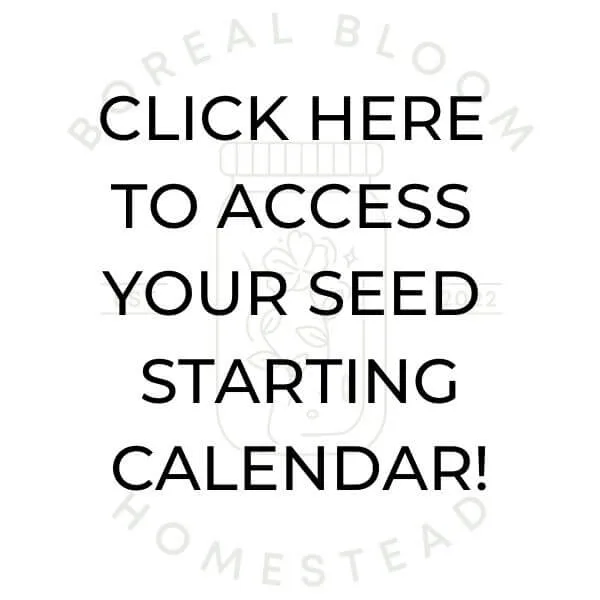
Why Start Your Own Seeds Indoors?
There's something pretty magical about growing your own food from tiny seeds. It's humbling to think about the work that goes into planting, maintaining, and harvesting crops for sustenance. The satisfaction in knowing you have provided nourishment for yourself and others is unparalleled.
Starting your own seeds indoors is the best way to get a jumpstart on the growing season. For northern growers like me, being able to start seeds indoors opens up a ton of crops that would take longer to mature than my growing season allows. It enables me to pick vine-ripened tomatoes in August, even though it's only been 90 frost-free days!
Psst. Starting your own seeds is an incredibly savvy gardening hack! Not only is it an economical choice compared to purchasing plants later on, but you can control the environment in which you grow those seedlings, organic, GMO-free, and fertilizer free.
Starting plants from seeds gives you access to more varieties of plants and offers flexibility with regard to earlier harvests, succession plantings, crop rotations, and companion plantings.
But, before you break out the grow light, heat mat, and soil blocker, it's a good idea to make a seed-starting schedule!
With a proper indoor seed sowing plan, you can easily schedule out what type of seeds to start and when, in order to have healthy, productive seedlings ready for transplant in time for optimal growth. Starting seeds indoors can be very rewarding and is an amazing part of gardening that every grower should experience!
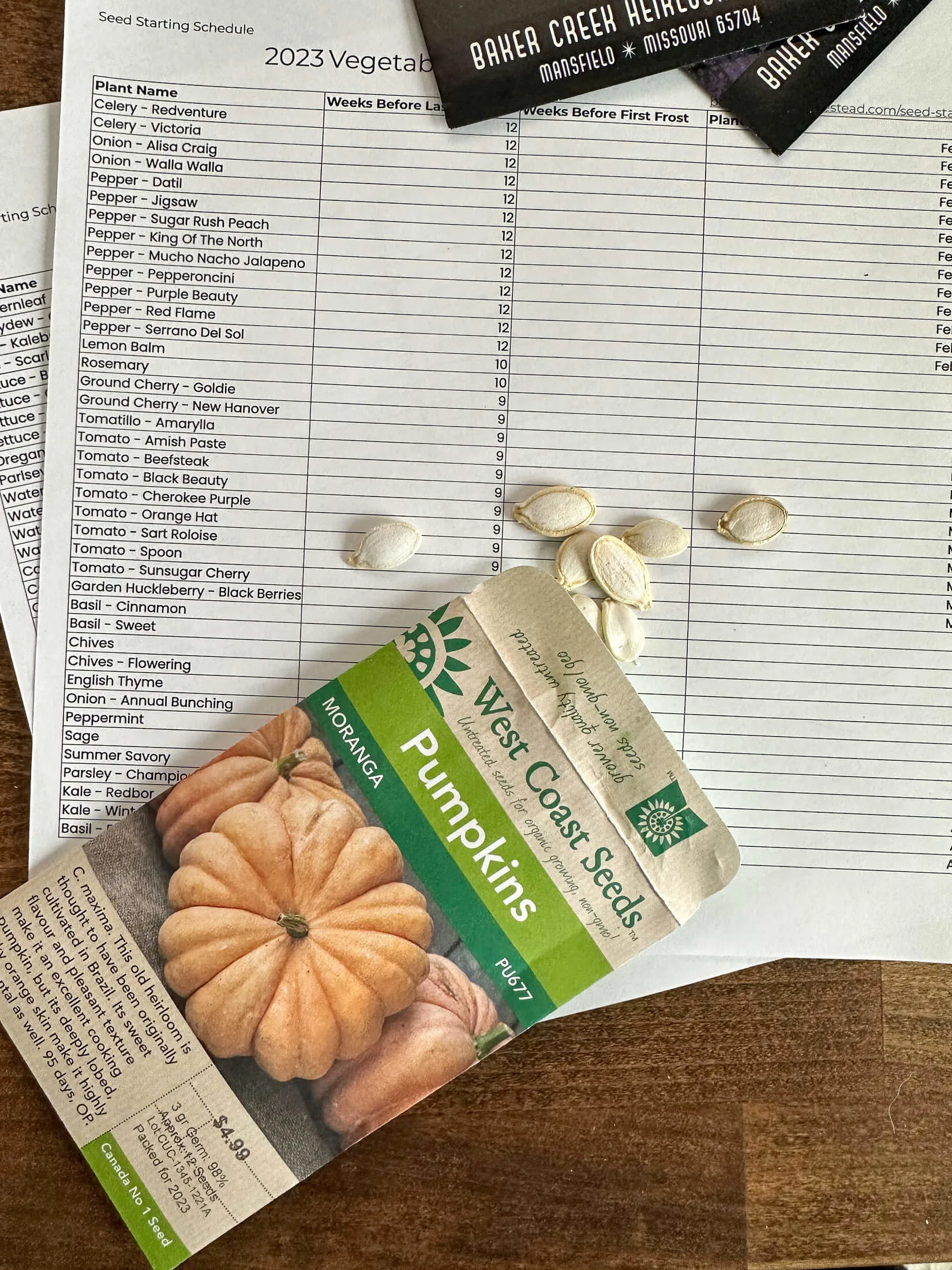
What Happens If You Seed Start At The Wrong Times?
Starting your seeds at the wrong times can be a big issue when it comes to having a successful garden and crops. But don't despair!
Planting seeds outdoors too early can spell disaster! Many seeds won't germinate in cold soils, instead, they decay and rot. Or if they do germinate, they grow slowly, stunted by the cool temperatures and short sunlight hours, and they can easily be taken out by an overnight frost.
Starting them too early indoors can lead to a number of problems. From plants that are too large to be grown inside, root-bound plants that don't recover and struggle to adapt to growing outside, or suffer from transplant shock when planted outdoors.
To leggy, spindly young plants due to lack of natural light. Plants that are started early, especially here with the low angle of the winter sun, require high-quality, artificial light. Not even a south-facing window will do!
On the other hand, sowing your seeds too late in the season means that your plants will take longer to reach maturity and may not have enough time to fruit by prime harvesting season which can lead to reduced harvest, or worse, no harvest.
There is a sweet spot for each and every plant - you want to plant it early enough that it has a strong headstart, but not so early that it suffers when planted outside in the early spring. For many plants, transplanting them when smaller is preferable as they will catch up and actually surpass larger plants that were started sooner in the same amount of time.
A great way to avoid these issues is by using a seed starting calendar custom-tailored to your growing zone, your frost dates, and the seeds you're starting.
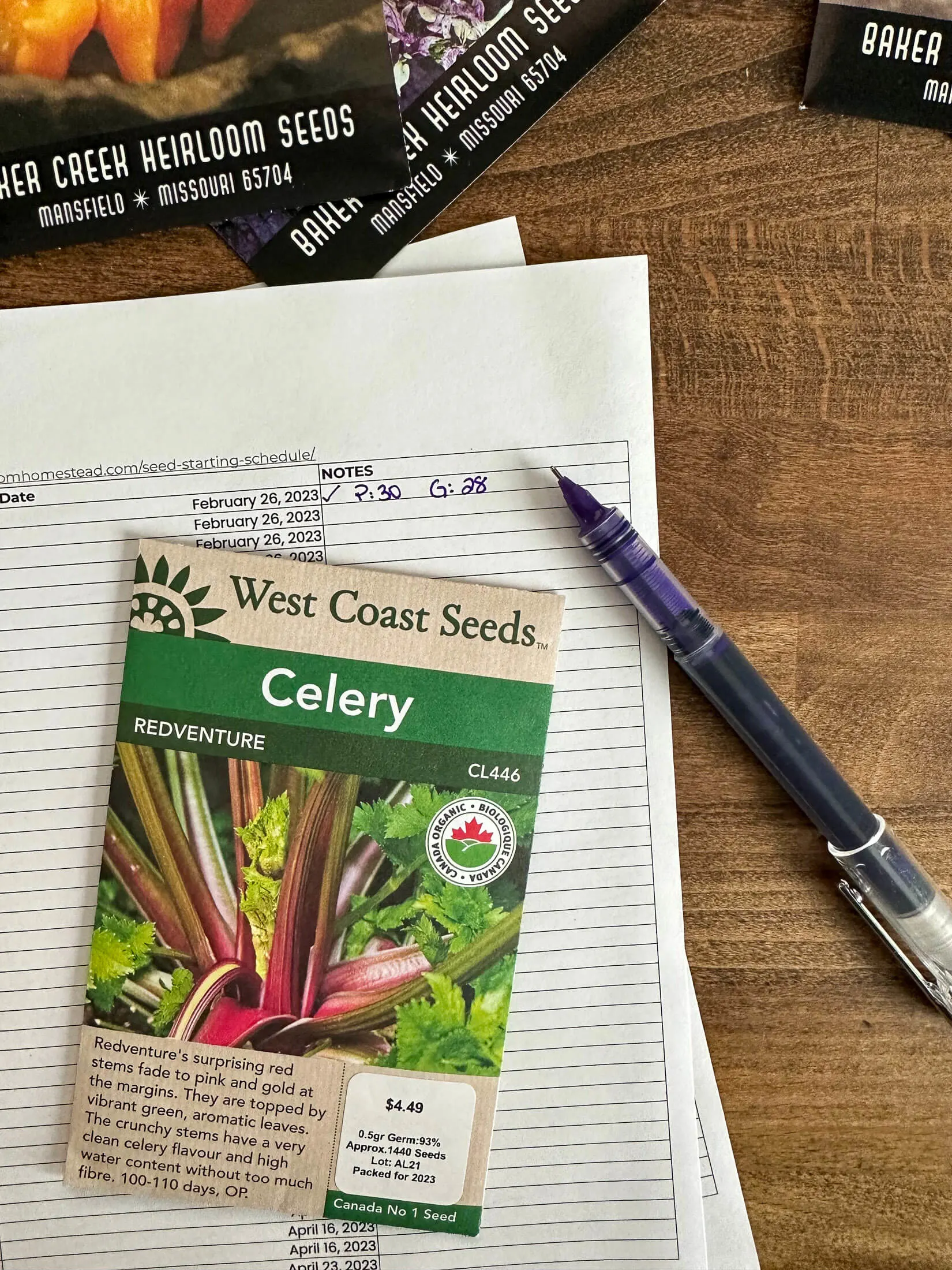
The Importance Of First And Last Frost Dates
Knowing your first and last frost dates can make the difference between a thriving garden, and one full of disappointment. Knowing what plants to start and when, which are cold hardy and which aren't, is critical to giving your garden the best chance of success.
The "first frost" date is the expected date of the first frost after the growing season. Knowing this date is important for farmers, gardeners, and homesteaders who need to plan when to harvest their crops. It also helps those who live in cold climates know when to expect temperatures to drop below freezing.
The "last frost" date is the expected date of the last time temperatures dip below freezing at the beginning of a growing season. This data is incredibly important to know, as it lays the foundation for the garden. It helps gardeners to plan their seed starts and transplant dates.
The difference between the first frost and the last frost is the number of frost-free days. While plants in your garden can grow long before and long after the last and first frost dates respectively, the tender plants like tomatoes, peppers, and cucumbers can only survive in the frost-free season.
Knowing the number of frost-free days in your garden helps you to pick the right plants for you! When looking at a seed package, you'll see a notation that says something like "100-110 days" this tells me that this plant takes between 100 and 110 days to reach maturity.
For my growing zone, with my last frost date of May 19, 2023, and my first frost date of September 16, 2023, I have a frost-free period of 120 days - this helps me know that I can grow celery in my zone without worrying that it won't mature before the danger of frost.
Thanks to Google, you can easily find out your local first and last frost dates, giving you an idea of when to start planting and harvesting. Keep in mind that these dates are only cold weather estimates, so it’s important to watch the weather, soil temperatures, and other conditions before making any decisions about what to grow and when.
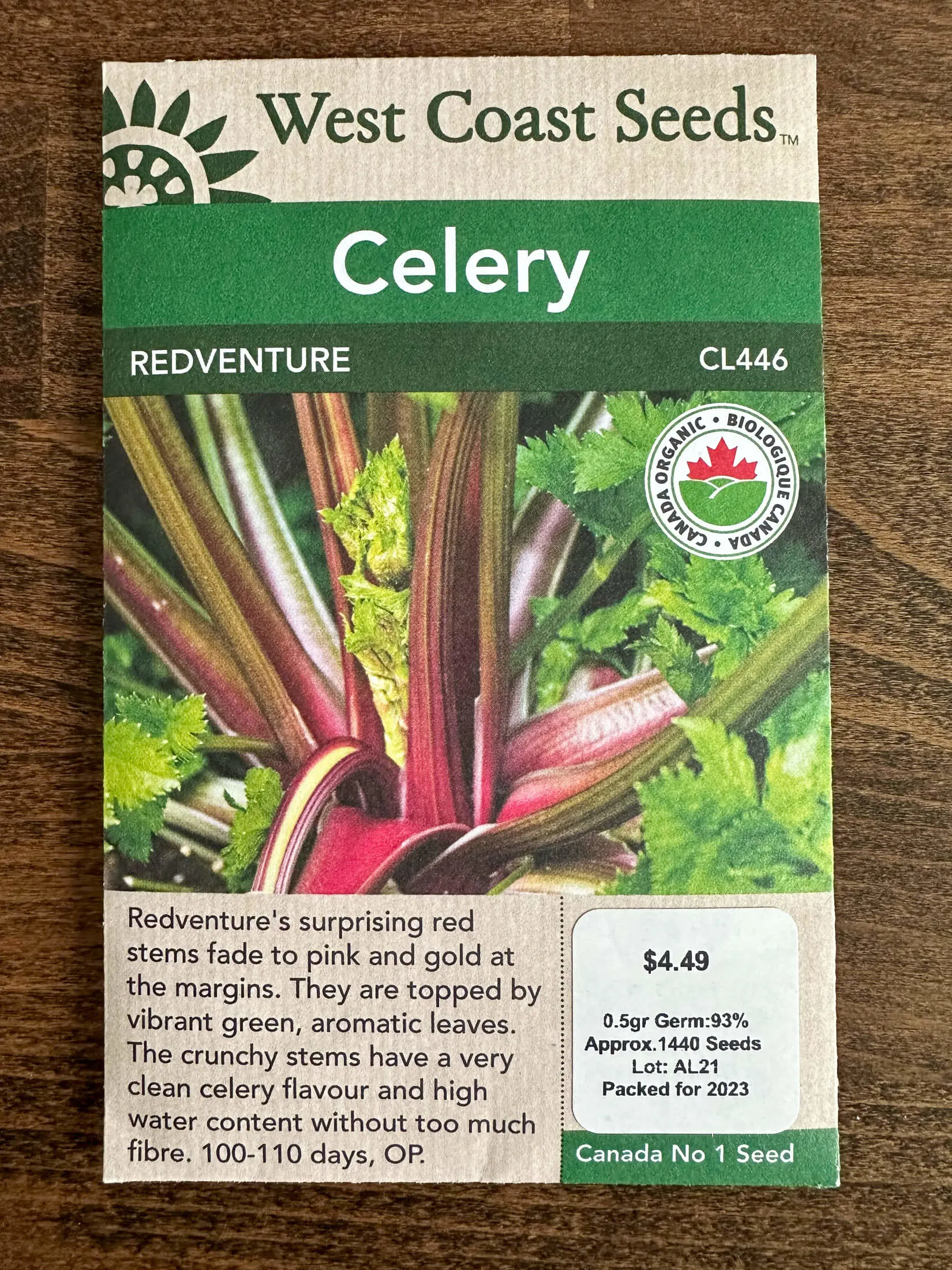
Growing Zones
Growing zones are geographical areas in which certain types of plants are most likely to flourish. In the United States, most growers use the USDA Hardiness Zones when determining what regions can support different kinds of plants and vegetables. This system divides the country into multiple climate zones based on extremes in temperature. Each zone has an appropriate range of winter minimum temperatures that can affect both flowering and vegetative growth in plants.
Similarly, Canadian growers often turn to The Canadian Hardiness Zone Map, which is a plant hardiness zone map created by Natural Resources Canada, to determine which type of plants will survive the given climatic conditions in any particular area.
Both these zoning systems provide great insight into helping gardeners choose the best varieties of plants to suit their climate and help ensure healthy harvests.
Although average frost dates within the growing zones are similar, they are not exact across the entire gardening zone. This is why it's important for gardeners to consider their own local temperatures, micro-climates, and conditions when planning their growing season. For example, my sister and I are in the same growing zone, but live about 30 km apart - her first frost in the summer occurs at least a full week prior to mine.
Plant hardiness zone maps are very useful, but may not give you the most accurate representations of your garden's potential. This is why I prefer to use first and last frost dates for my garden planning.

Planting Calendar For Every Growing Zone
Planting a successful vegetable or flower garden can seem like a daunting task, particularly when focusing on the little things. There is so much excitement surrounding a new garden with many things to remember, from selecting and ordering the best seeds for your garden to knowing when and how to plant them.
To make it all a little bit easier, I have created a customizable, printable seed starting calendar specific to YOUR growing zone so that you can plan ahead and know precisely when to start your seeds.
Whether you are a novice gardener or an experienced one, this planting calendar will ensure you have a smooth system when it comes time to get those first little seedlings in the ground!
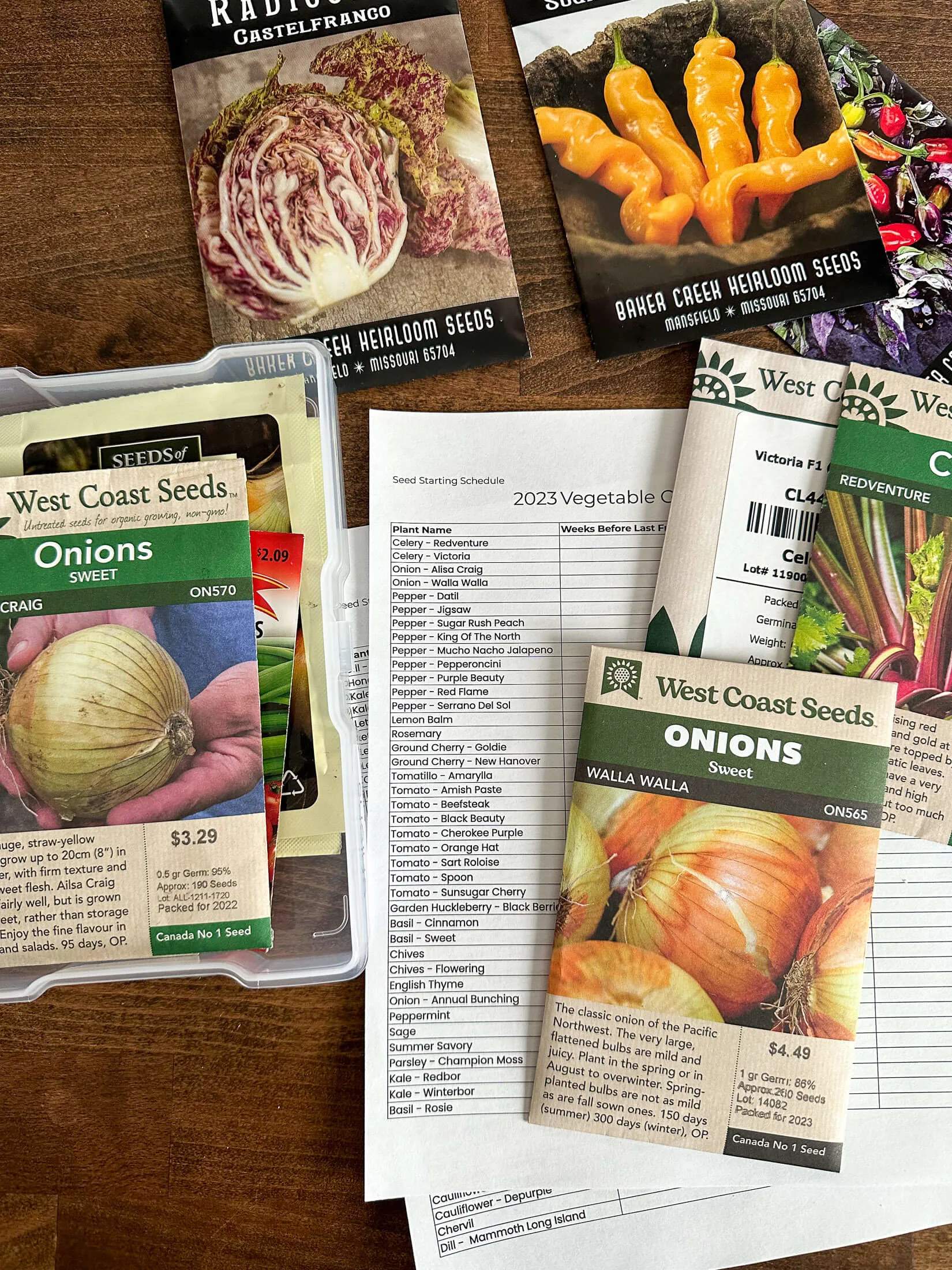
Tips For Using The Seed Starting Chart:
No. 1 --> Choose a day of the week you'll want to do your planting. For me, Sundays are a nice day to tackle planting chores, so I'll input my last frost date as the nearest Sunday. Where my chart says May 19th, I would input May 21st to catch schedule my planting days each Sunday.
No. 2 --> Use your discretion when it comes to choosing when to plant. Some seed packets give you a long range of time to plant before the last frost. Some plants, like celery, which can take between 20 and 30 days to germinate, would benefit from being started 12 weeks prior to the last frost date, while tomato plants can vigorously and quickly outgrow the space you have indoors, should be planted 6 or 7 weeks before the last frost instead of 10 weeks.
No. 3 --> If you're new at this, don't stress. Plants have been surviving and thriving since long before people started to meddle in their growth. Take your time, sow seeds, offer them the proper conditions to germinate, take care of your little seedlings, and you'll be off to the races.
No. 4 --> Reduce your reliance on plastic and peat pots when starting seedlings by using soil block makers for your seed starts. Soil blockers compress peat moss and potting mix to create a self-sustaining seeding pod, kind of like peat pellets. We used them last year and had a phenomenally productive garden!
No. 5 --> Transplant times for your pre-started seedlings, as a general guideline, are shortly after the last expected frost. That said, different crops require different environmental conditions. Here, tomato plants suffer if they're planted before June - for some reason, the month of May is always windy and the 'maters don't like it. Cole crops and leafy greens are fine to hit the garden once they are hardened off.
No. 6 --> Some seed companies will indicate if the seeds should be direct sown, if there is no indication of timing, it's safe to assume that those seeds should be direct sown.
No. 7 --> Consider the plant's likes and dislikes! New gardeners, don't panic, I only mean to consider whether a plant tolerates transplanting well. Usually, pumpkins don't appreciate being transplanted, and by the time they get over the shock of it all, a direct sown plant will be outperforming your transplant. Root vegetables also prefer to be direct sown and suffer after transplanting.
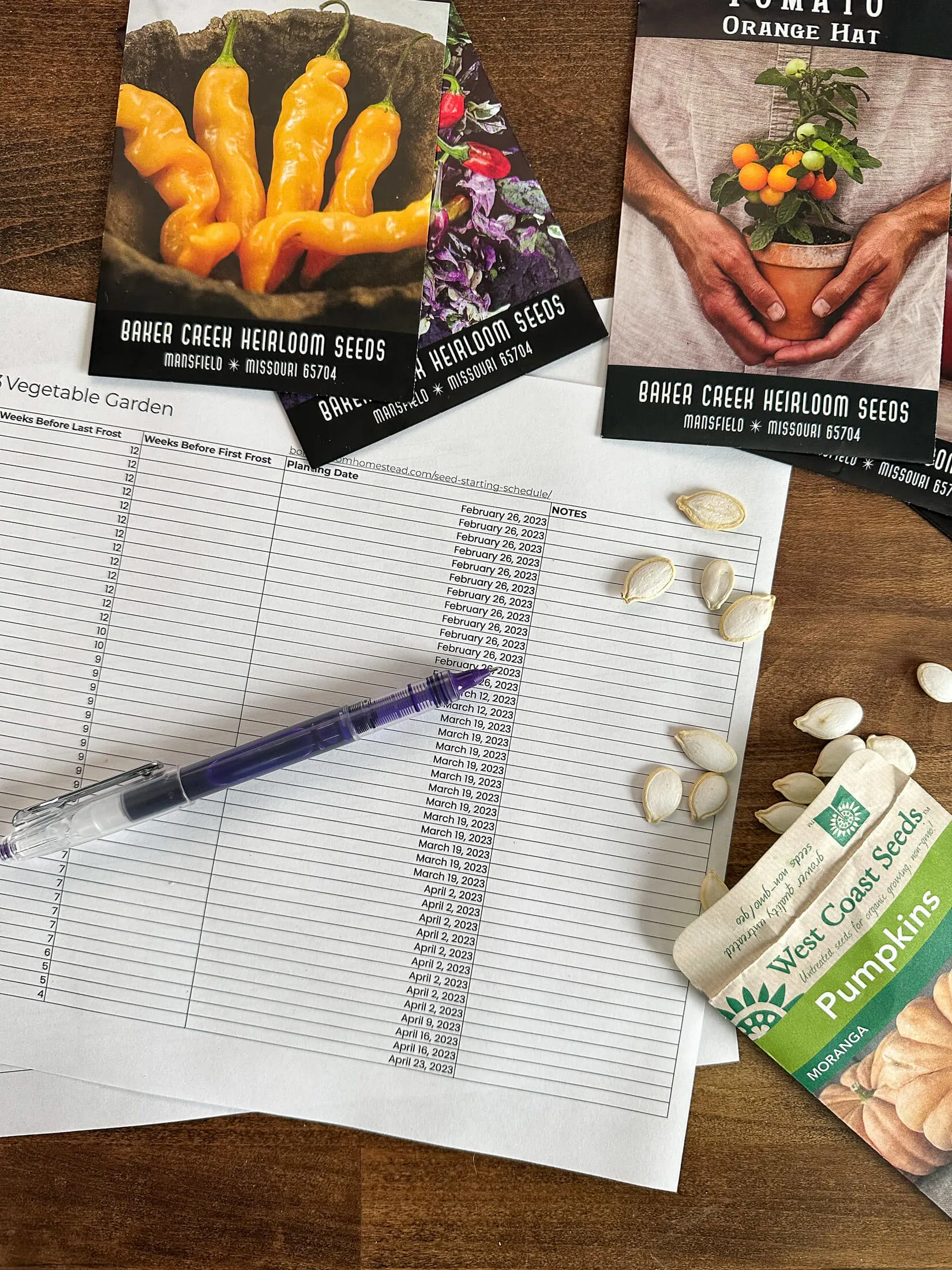
How To Use The Seed Starting Calendar
Don't be intimidated, this easy document does ALL the math and calculating for you. You can download your own copy by clicking the photo below this tutorial!
Step 1. Find your first and last frost dates:
The easiest way to do that is to jump over to the Almanac website and type in your zip code, town or city, and state or province. This website works for both Americans and Canadians.

If you're Canadian a GREAT resource, one that I use, is ClimateAtlas.ca. This interactive map indicates not only first and last frost, but frost-free days, growing heat units, and a lot more if you're into that kind of stuff.
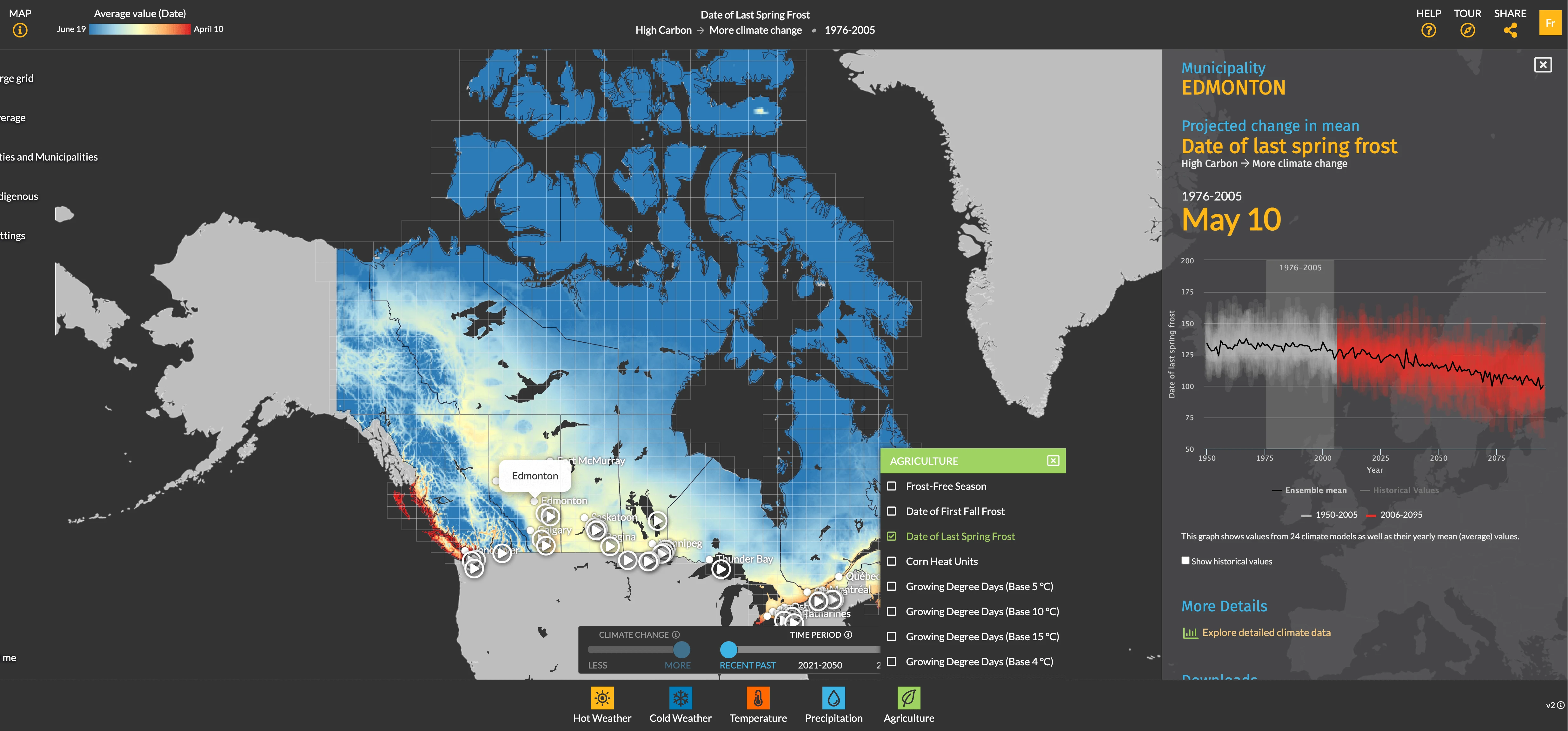
Step 2. Input your growing information
On the first tab, titled INFORMATION, of the Seed Starting Schedule, add the name of your garden, the growing year, and your first and last frost dates. The spreadsheet will calculate your frost-free days.
I've included a garden name in case you're planting more than one garden or like me, you prefer to separate your flowers from your food crops. It's nice to include the year so you can keep a record of your growth over the years to refer back to!
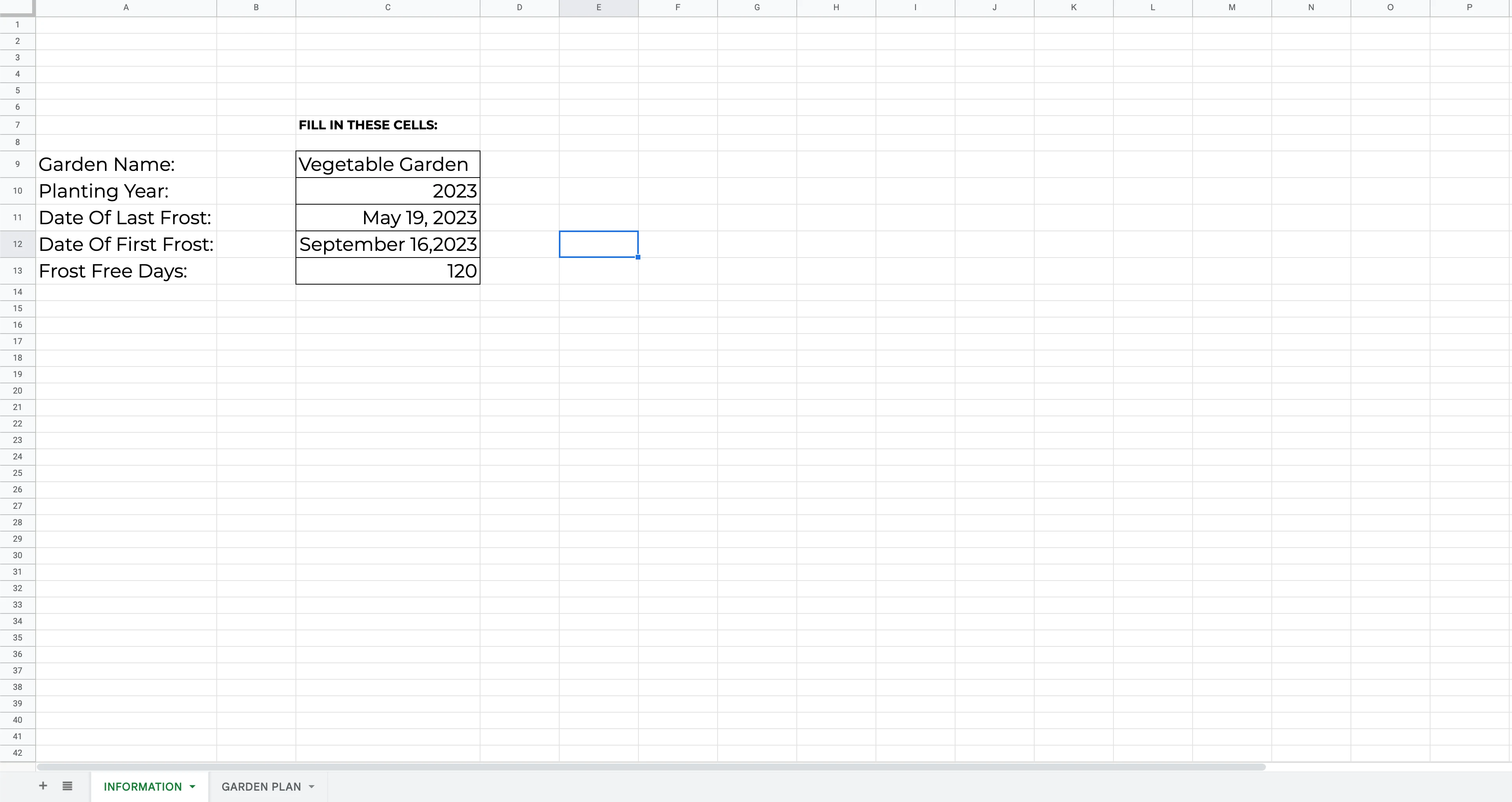
Step 3. Read the seed packets
On every seed packet that you buy, there will be all the information you need to know to quickly populate this chart. I like to use the common name followed by a dash and then the variety. This helps later on for filtering. When filling in weeks before frost, don't include a range as the formula can't parse ranges.
Some plants have the option of planting a second crop and the second crop must be planted before the first frost date, input the number of weeks prior to first frost in that column. Unfortunately, the formulas cannot kick out two dates, so you'll have to enter each planting as a separate line item.
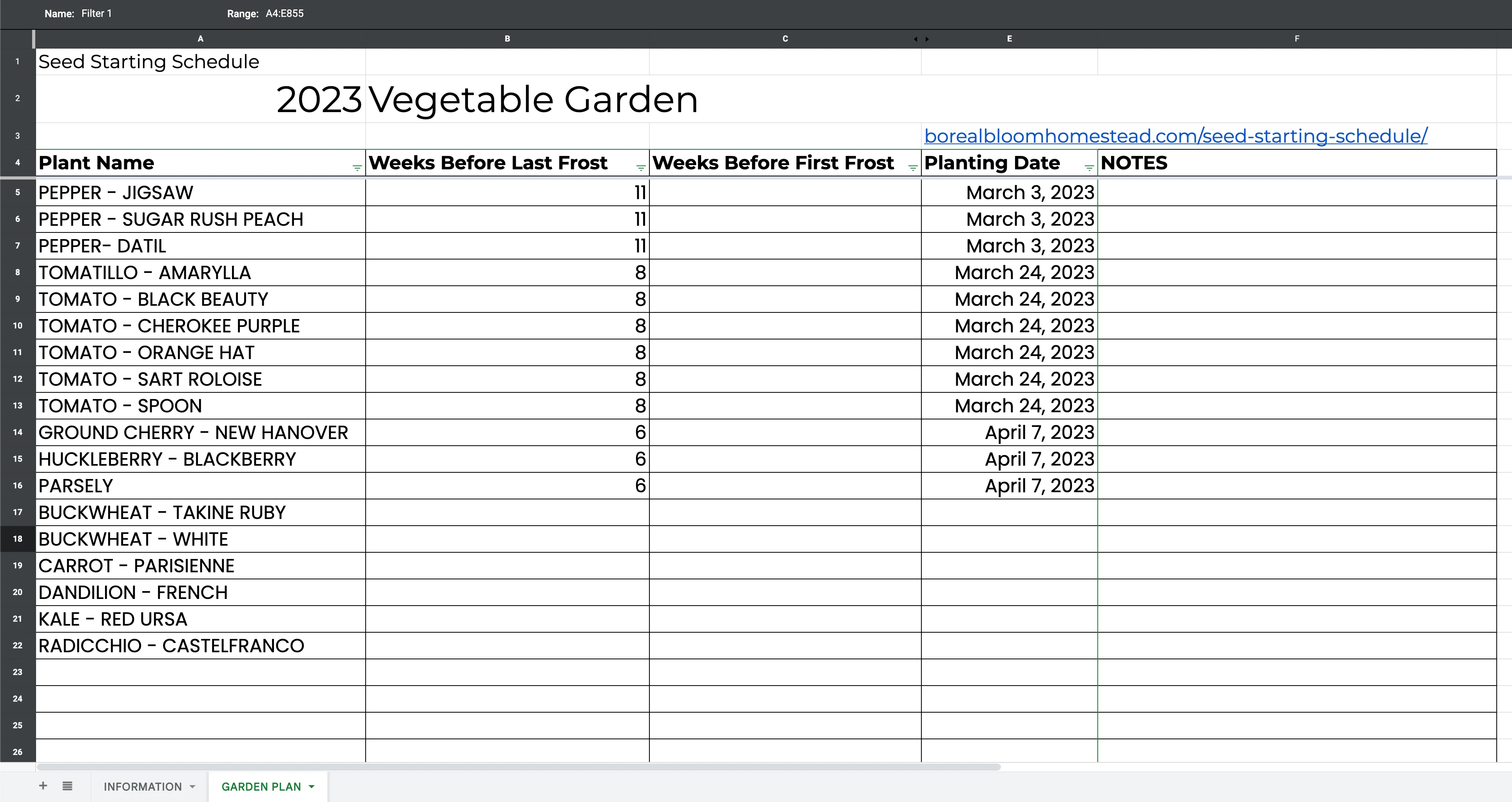
Step 4. Admire your hard work
Once you've gotten all of your seeds inputted into the chart, it may look a little chaotic, so it's time to sort the rows!
Click the funnel at the top of each column to sort the schedule as you like. I like to sort by Planting Date: A to Z, to show the soonest planting dates first. It's also nice to sort by Plant Name for a quick at-a-glance at what's going in the garden this year,

Step 5. Take notes
I've included a column on the far right for notes. Helpful notes include the number of plants I planted, the number of plants I transplanted, and whether or not I had enough yield for each plant at the end of harvest.
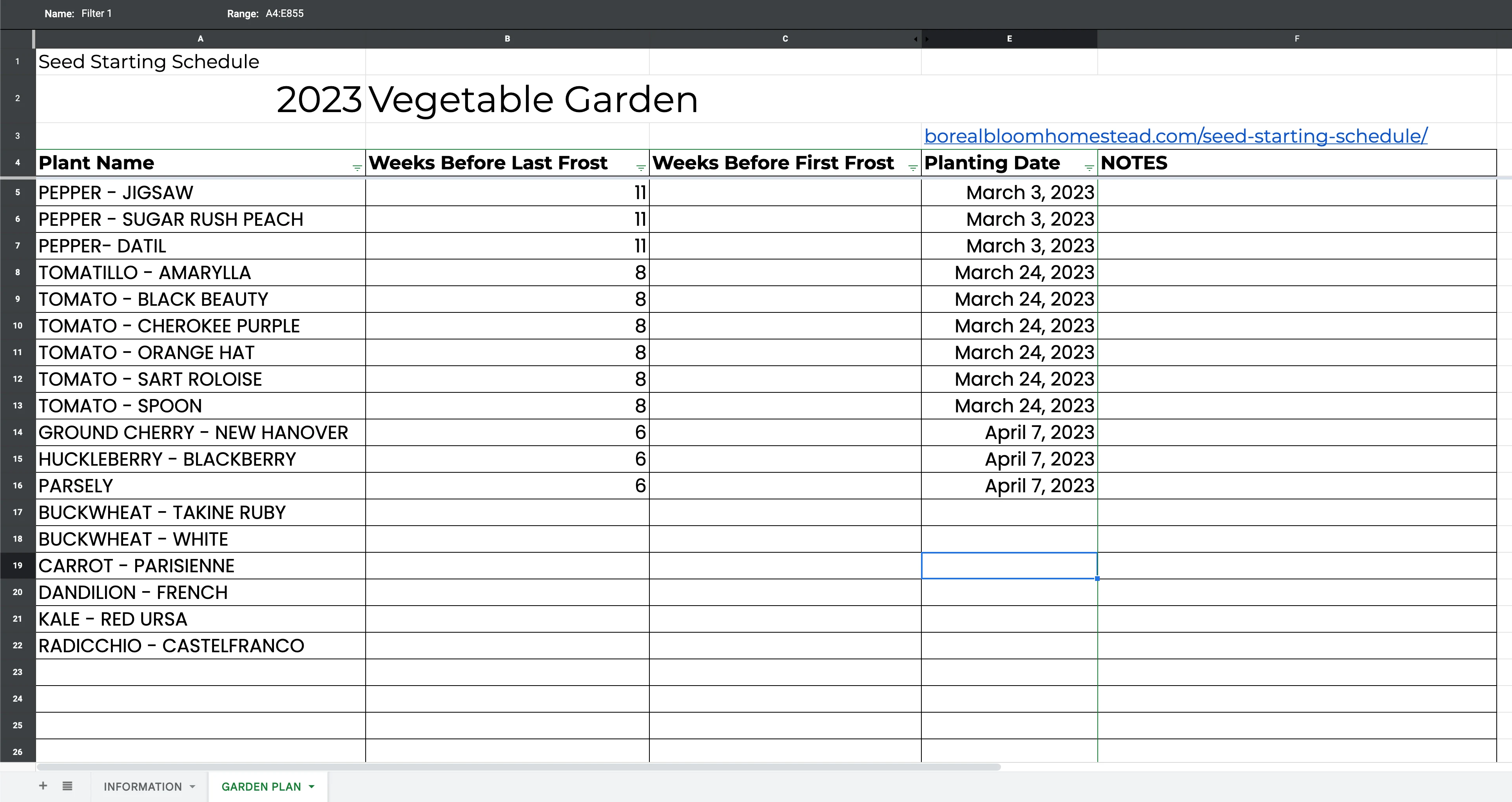
Step 6. Get The Spreadsheet!

More Great Growing Content!
Notes From The Homestead Garden
Using a seed-starting calendar is a great way to help plan and track your seed-starting progress. It can help make sure you know when to plant which seeds and keep helpful notes on how your garden progresses over time. With the right information, knowledge, and planning, anyone can have a successful and bountiful garden!
Get started by downloading the seed-starting calendar, inputting your growing information from your seed packets, putting the data to use, and getting your hands in the dirt! Good luck, from my garden to yours!
Pin This FREE Printable Seed Starting Schedule!
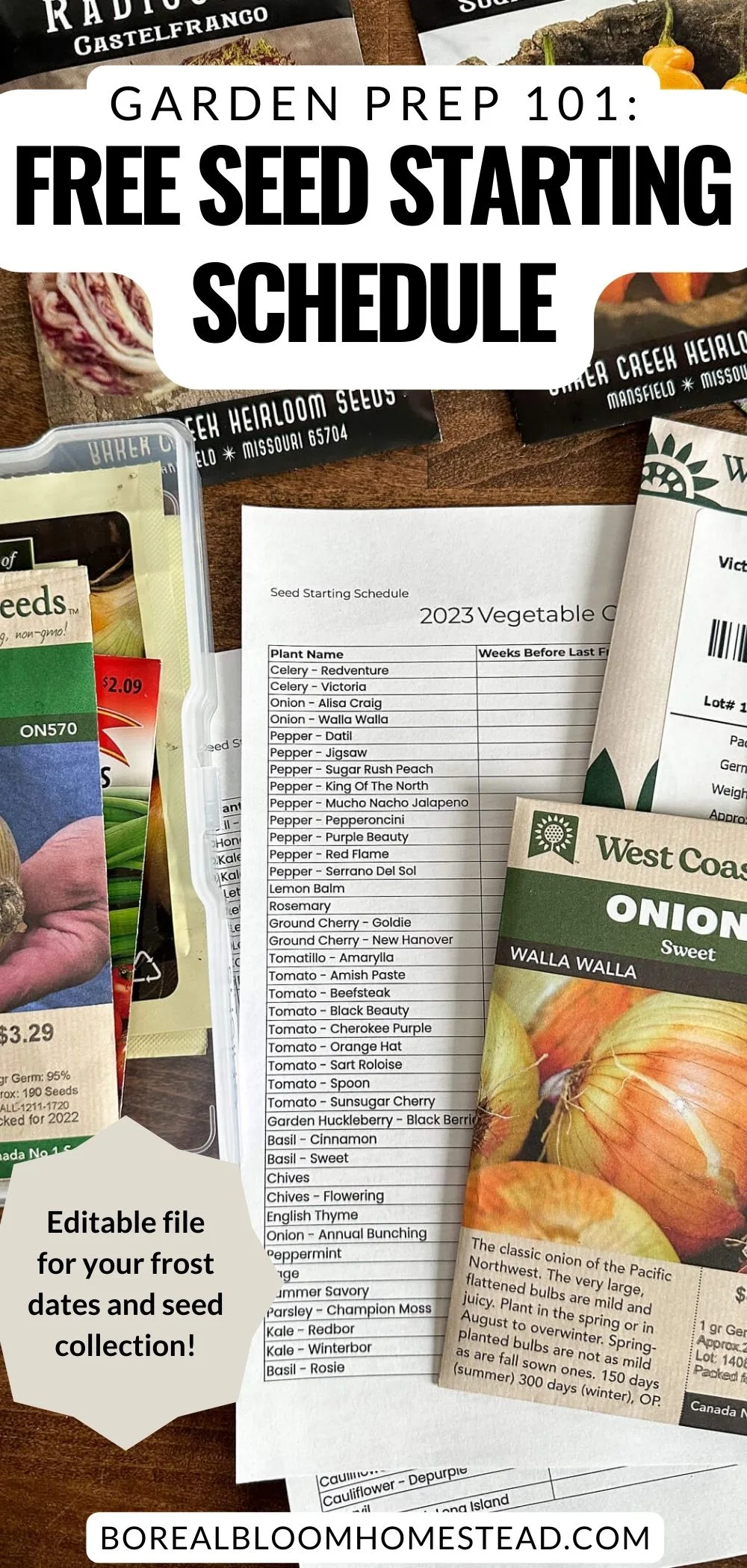
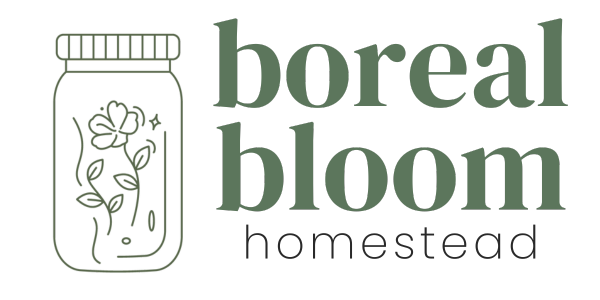
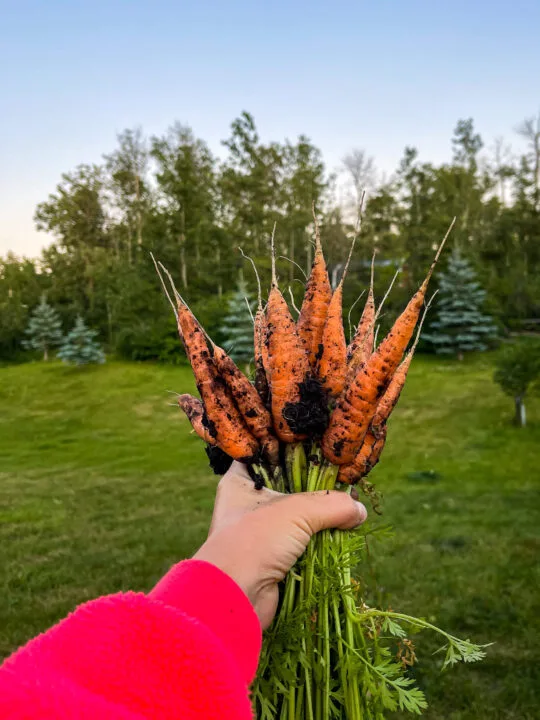
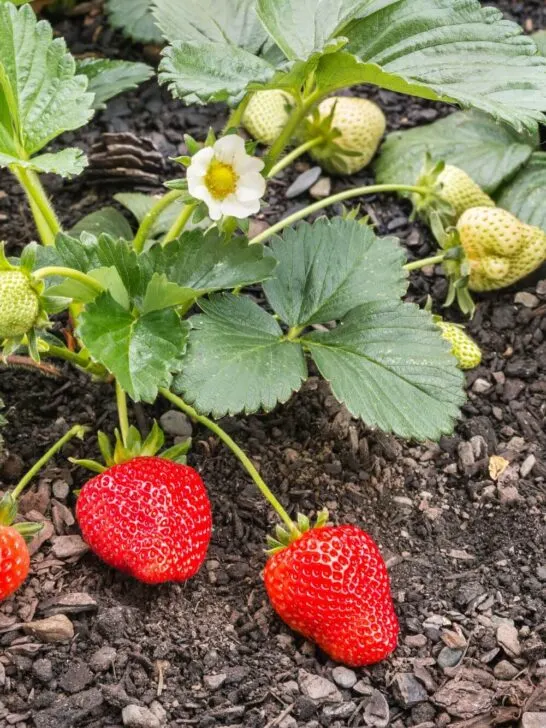
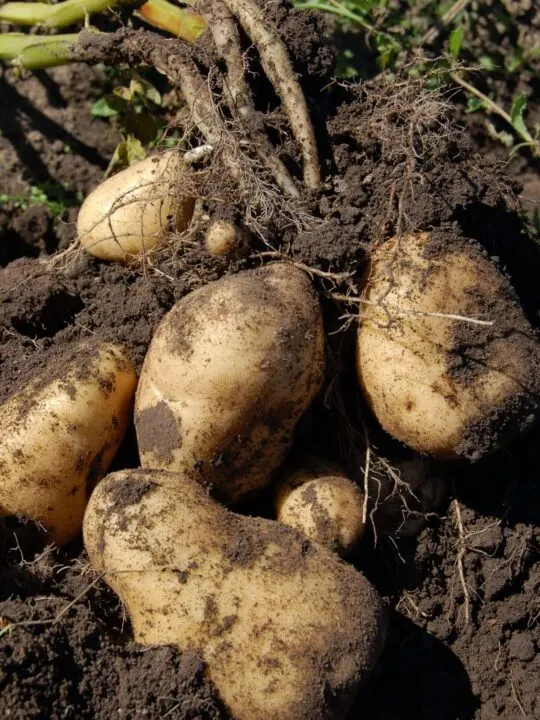
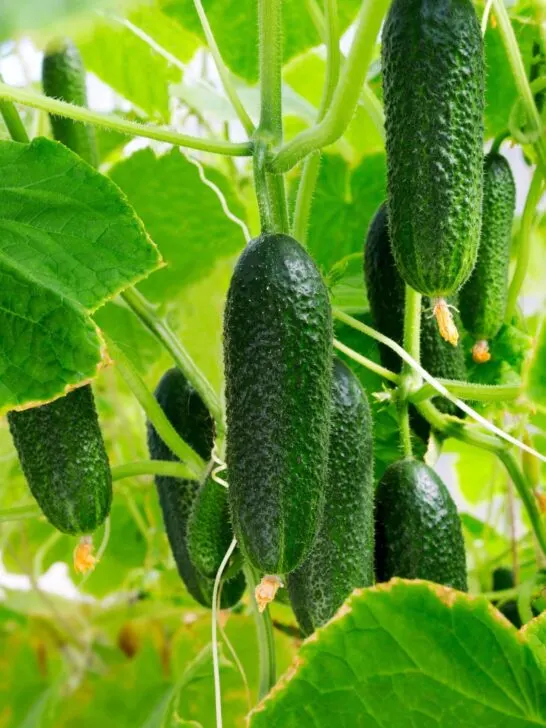
Shell
Thursday 25th of January 2024
So I'm forced to get a grow.me account to sign up for your free growing calendar? That's not free. I have enough apps to track things. I don't need another one.
Ally
Friday 26th of January 2024
Grow.me is a platform that allows you to share, bookmark, and save articles that you may like across many, many websites and allows me to collect emails for my newsletter so I can easily share new content with my readers.
I understand that you're not interested in signing up for my email list, but a little kindness and grace can go a long way, especially because there's a real live human on the other side of the screen. Saying "hey, I'd rather not sign up for another list, is there any way that we can scoot around that?" would have not only opened the lines of communication, but also collaboration, and I'd have offered to email it to you, but it seems like we're not a good fit. I hope you find what you're looking for.